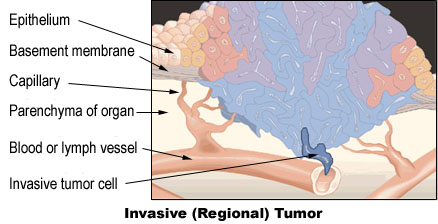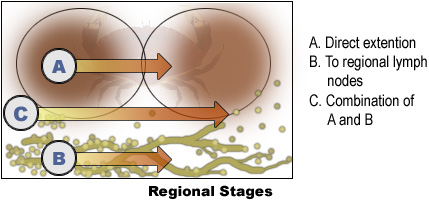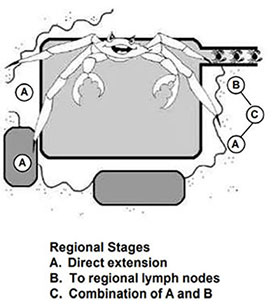Codes 2-4: Regional
- Broadest category and most difficult to properly identify
- Boundary between localized and regional tumor extension is usually identified; however, the boundary between regional and distant spread is not always clear and can be defined differently by physicians in various specialties
- Becomes regional when there is potential for spread by more than one lymphatic or vascular supply root
- Tumor extension beyond the limits of the organ or origin

Figure 1. Invasive (regional) tumor.
Source: Adapted from an illustration by Brian Shellito of Scientific American, as printed in Cancer in Michigan, The Detroit News, Nov. 1-2, 1998.
For example, a tumor in the hepatic flexure of the colon with extension along the lumen to the ascending colon is staged as localized because both areas drain to the same lymph nodes. On the other hand, a sigmoid colon tumor extending into the rectum is staged as regional because the tumor now has potential for the tumor cells to drain to both the iliac and the mesenteric nodes.
Regional stage has three different categories.

Figure 2. Regional stage.
Source: Adapted from an illustration by Brian Shellito of Scientific American, as printed in Cancer in Michigan, The Detroit News, Nov. 1-2, 1998.
Code Definitions for 2-4
Code 2: Regional by direct extension only
- Invasion through entire wall or organ into surrounding organs/adjacent tissues
- Regional by direct extension or contiguous spread
Code 3: Regional lymph nodes involved only
- Tumor is localized (code 1)
- Tumor invasion of walls of lymphatics where cells can travel through lymphatic vessels to nearby lymph nodes where they are “filtered” out and begin to grow in the nodes
Code 4: Regional by BOTH direct extension AND lymph node involvement
- A combination of direct extension (code 2) and lymph node involvement (code 3)
Clinicians may use some terms differently than cancer registrars do. Therefore, it is important to understand the words used to describe the spread of the cancer and how they are used in staging. For example
- Local: “Local” as in “carcinoma of the stomach with involvement of the local lymph nodes.” Local nodes are the first group of nodes to drain the primary. Unless evidence of distant spread is present, such a case should be staged as regional lymph nodes, not localized
- Regional: “Metastases” as in “carcinoma of the lung with peribronchial lymph node metastases.” Metastases in this sense means that the regional (peribronchial) lymph nodes are involved by tumor. Such a case would still be staged as regional lymph nodes. Learn the names of regional nodes for each primary site (see the Summary Stage Manual for details)

Figure 3. Regional stage by direct extension and lymph node.
Source: Young JL Jr, Roffers SD, Ries LAG, Fritz AG, Hurlbut AA (eds). SEER Summary Staging Manual - 2000: Codes and Coding Instructions, National Cancer Institute, NIH Pub. No. 01-4969, Bethesda, MD, 2001.
Updated: November 5, 2024
Suggested Citation
SEER Training Modules: Codes 2-4: Regional. U.S. National Institutes of Health, National Cancer Institute. Cited 04 January 2026. Available from: https://training.seer.cancer.gov.




